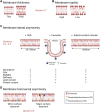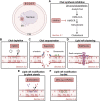Alteration of cholesterol distribution at the plasma membrane of cancer cells: From evidence to pathophysiological implication and promising therapy strategy
- PMID: 36439249
- PMCID: PMC9682260
- DOI: 10.3389/fphys.2022.999883
Alteration of cholesterol distribution at the plasma membrane of cancer cells: From evidence to pathophysiological implication and promising therapy strategy
Abstract
Cholesterol-enriched domains are nowadays proposed to contribute to cancer cell proliferation, survival, death and invasion, with important implications in tumor progression. They could therefore represent promising targets for new anticancer treatment. However, although diverse strategies have been developed over the years from directly targeting cholesterol membrane content/distribution to adjusting sterol intake, all approaches present more or less substantial limitations. Those data emphasize the need to optimize current strategies, to develop new specific cholesterol-targeting anticancer drugs and/or to combine them with additional strategies targeting other lipids than cholesterol. Those objectives can only be achieved if we first decipher (i) the mechanisms that govern the formation and deformation of the different types of cholesterol-enriched domains and their interplay in healthy cells; (ii) the mechanisms behind domain deregulation in cancer; (iii) the potential generalization of observations in different types of cancer; and (iv) the specificity of some alterations in cancer vs. non-cancer cells as promising strategy for anticancer therapy. In this review, we will discuss the current knowledge on the homeostasis, roles and membrane distribution of cholesterol in non-tumorigenic cells. We will then integrate documented alterations of cholesterol distribution in domains at the surface of cancer cells and the mechanisms behind their contribution in cancer processes. We shall finally provide an overview on the potential strategies developed to target those cholesterol-enriched domains in cancer therapy.
Keywords: anticancer therapy; apoptosis; cancer; caveolae; cell migration; cell proliferation; lipid rafts; submicrometric domains.
Copyright © 2022 Maja and Tyteca.
Conflict of interest statement
The authors declare that the research was conducted in the absence of any commercial or financial relationships that could be construed as a potential conflict of interest.
Figures





Similar articles
-
Sterol carrier protein-2 selectively alters lipid composition and cholesterol dynamics of caveolae/lipid raft vs nonraft domains in L-cell fibroblast plasma membranes.Biochemistry. 2003 Dec 16;42(49):14583-98. doi: 10.1021/bi034966+. Biochemistry. 2003. PMID: 14661971
-
Selective cholesterol dynamics between lipoproteins and caveolae/lipid rafts.Biochemistry. 2007 Dec 4;46(48):13891-906. doi: 10.1021/bi700690s. Epub 2007 Nov 9. Biochemistry. 2007. PMID: 17990854
-
Surface cholesterol-enriched domains specifically promote invasion of breast cancer cell lines by controlling invadopodia and extracellular matrix degradation.Cell Mol Life Sci. 2022 Jul 12;79(8):417. doi: 10.1007/s00018-022-04426-8. Cell Mol Life Sci. 2022. PMID: 35819726 Free PMC article.
-
Lipid rafts as major platforms for signaling regulation in cancer.Adv Biol Regul. 2015 Jan;57:130-46. doi: 10.1016/j.jbior.2014.10.003. Epub 2014 Oct 27. Adv Biol Regul. 2015. PMID: 25465296 Review.
-
Recent progress on lipid lateral heterogeneity in plasma membranes: From rafts to submicrometric domains.Prog Lipid Res. 2016 Apr;62:1-24. doi: 10.1016/j.plipres.2015.12.004. Epub 2015 Dec 29. Prog Lipid Res. 2016. PMID: 26738447 Free PMC article. Review.
Cited by
-
Cholesterol effects on the tumor immune microenvironment: from fundamental concepts to mechanisms and implications.Front Oncol. 2025 Apr 9;15:1579054. doi: 10.3389/fonc.2025.1579054. eCollection 2025. Front Oncol. 2025. PMID: 40270603 Free PMC article. Review.
-
Targeting cholesterol impairs cell invasion of all breast cancer types.Cancer Cell Int. 2024 Jan 10;24(1):27. doi: 10.1186/s12935-023-03206-z. Cancer Cell Int. 2024. PMID: 38200575 Free PMC article.
-
Cholesterol depletion suppresses thermal necrosis resistance by alleviating an increase in membrane fluidity.Sci Rep. 2025 Mar 24;15(1):10133. doi: 10.1038/s41598-025-92232-0. Sci Rep. 2025. PMID: 40128234 Free PMC article.
-
Drug-Induced Reorganisation of Lipid Metabolism Limits the Therapeutic Efficacy of Ponatinib in Glioma Stem Cells.Pharmaceutics. 2024 May 29;16(6):728. doi: 10.3390/pharmaceutics16060728. Pharmaceutics. 2024. PMID: 38931850 Free PMC article.
-
Development of a chemically disclosed serum-free medium for mouse pluripotent stem cells.Front Bioeng Biotechnol. 2024 May 15;12:1390386. doi: 10.3389/fbioe.2024.1390386. eCollection 2024. Front Bioeng Biotechnol. 2024. PMID: 38812912 Free PMC article.
References
Publication types
LinkOut - more resources
Full Text Sources

